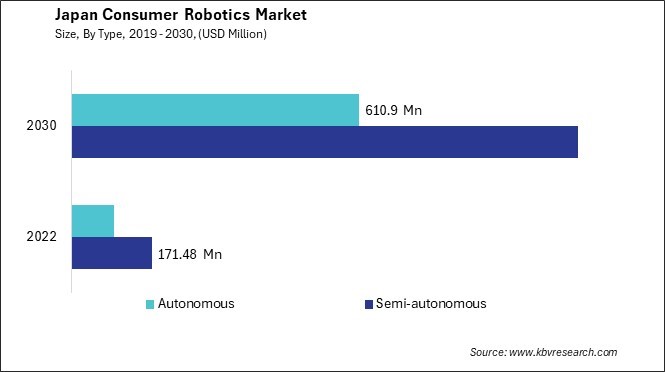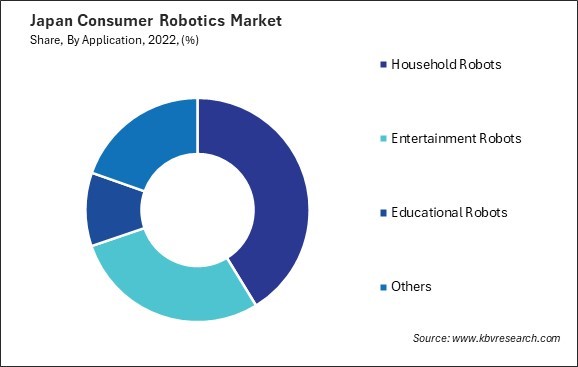The Japan Consumer Robotics Market size is expected to reach $1.7 Billion by 2030, rising at a market growth of 26.4% CAGR during the forecast period.
The consumer robotics market in Japan has witnessed significant growth and innovation in recent years, fueled by advancements in technology, changing consumer preferences, and a rapidly aging population. One of the key drivers of the consumer robotics market in Japan is the country's aging population. With many elderly citizens, there is increasing demand for robotic solutions that assists with household chores, healthcare, and companionship. As a result, companies have been investing heavily in developing robots specifically designed to cater to the needs of older adults.

Robotic companions, in particular, have gained popularity in Japan, offering companionship and assistance to individuals living alone or experiencing social isolation. These robots are equipped with advanced artificial intelligence (AI) capabilities, enabling them to engage in natural conversations, provide entertainment, and offer reminders for medication or appointments. Additionally, some robotic companions are equipped with sensors to monitor the well-being of their users and alert caregivers in emergencies.
Furthermore, Japan's consumer robotics market is driven by the country's culture of innovation and technological excellence. Japanese companies continually push the boundaries of what is possible with robotics, developing robots that performs increasingly complex tasks quickly and accurately. From humanoid robots capable of mimicking human movements to robotic pets that respond to touch and voice commands, Japan remains at the forefront of robotic innovation.
The COVID-19 pandemic has had a profound impact on the consumer robotics market in Japan, accelerating the adoption of robotic solutions in various sectors. With social distancing measures and hygiene protocols becoming the new norm, there has been a heightened demand for robots that perform tasks autonomously, minimizing human contact and reducing the risk of virus transmission.
In the healthcare sector, robots have played a crucial role in frontline response efforts, assisting healthcare workers in disinfection, patient care, and telemedicine. Robots equipped with ultraviolet (UV) disinfection technology have been deployed in hospitals and public spaces to sanitize high-touch surfaces and minimize the spread of the virus. Telepresence robots in Japan have enabled remote communication and virtual consultations, allowing healthcare providers to interact with patients while minimizing exposure to infectious agents.
The consumer robotics market in Japan has witnessed a significant surge in the adoption of industrial robots, marking a notable trend in recent years. Japan's long-standing leadership in industrial automation has laid a solid foundation for the expansion of robotics across various sectors. The country's manufacturing prowess, characterized by precision engineering and advanced robotics, has provided a rich ecosystem for developing and deploying robotic solutions.
According to the International Trade Administration, as of 2022, 45% of all industrial robots in the world were originally produced or designed by companies in Japan. Orders for industrial robots from Japanese manufacturers hit a record $7.35 billion in 2022, up 1.6% from the previous year. Japan had 631 robots working in the manufacturing sector for every 10,000 humans in 2021.
As industries harness robotics for manufacturing efficiency, there's a natural progression towards leveraging similar technologies in consumer-oriented products. This trend underscores Japan's position as a frontrunner not only in industrial robotics but also in the broader spectrum of robotics applications, promising further advancements and innovations in both sectors.
Furthermore, collaborations between industrial robotics companies and consumer electronics manufacturers have accelerated the cross-pollination of technologies and expertise. Joint research initiatives, strategic partnerships, and investments have facilitated the transfer of knowledge and resources between the industrial and consumer robotics sectors, fostering innovation and industry growth. Thus, Japan's leadership in industrial robotics and strategic collaborations drive innovation and growth across industrial and consumer robotics sectors, shaping the future of robotics globally.
The consumer robotics market in Japan is witnessing a significant surge in the adoption of household robots, marking a notable shift in how people interact with technology within their homes. One of the key drivers behind the growing adoption of household robots is the aging population in Japan. With a rapidly increasing elderly demographic, there is a rising demand for robotic solutions that assists with everyday tasks and provide companionship to the elderly.
Additionally, Japan's highly urbanized society and busy lifestyles have led to a growing need for time-saving technologies. Household robots are integrated into daily routines to automate repetitive tasks such as cleaning, cooking, and home security. From robotic vacuum cleaners to automated kitchen appliances, these technologies offer convenience and efficiency to busy households, freeing up time for other activities.
The Japanese government has also supported adopting robotics technology and implemented initiatives to promote innovation and investment in the robotics industry. This has fostered a favorable environment for companies developing household robots, leading to a proliferation of products tailored to meet the diverse needs of Japanese consumers. Therefore, Japan's burgeoning consumer robotics market is driven by an aging population, urbanization, and government support, revolutionizing domestic life with convenient and innovative solutions.

The consumer robotics market in Japan is a dynamic and rapidly growing sector characterized by a diverse range of companies innovating in various niches. One prominent player in the Japanese consumer robotics market is SoftBank Robotics. Established in 2012, SoftBank Robotics is a subsidiary of SoftBank Group Corp, a leading telecommunications and technology conglomerate in Japan. SoftBank Robotics is known for its humanoid robot Pepper, which has gained widespread popularity in Japan. Pepper is designed to interact with humans through conversation and gestures, making it suitable for applications such as customer service, education, and entertainment. SoftBank Robotics has also ventured into developing other robotic solutions, including Whiz, an autonomous cleaning robot for commercial spaces.
Another key player in the Japanese consumer robotics market is Sony Corporation. While Sony is renowned for its electronics and entertainment products, the company has also made significant strides in robotics technology. Sony's Aibo robotic dog is a prime example of its innovation in consumer robotics. Aibo combines artificial intelligence with advanced sensors and actuators to simulate the behavior of a real dog, offering companionship and entertainment to users. With its lifelike movements and interactive capabilities, Aibo has garnered a dedicated fan base in Japan.
In addition to established corporations, Japan's consumer robotics market is characterized by a vibrant ecosystem of startups and innovative ventures. One such company is Groove X, founded by the former CEO of SoftBank Robotics, Kaname Hayashi. Groove X gained attention with its Lovot robot, designed to evoke feelings of love and companionship. The company aims to address the social isolation and loneliness prevalent in Japanese society through robotics technology.
Furthermore, Japanese companies like Honda Motor Co., Ltd. have a long-standing presence in the robotics industry. Honda's ASIMO robot, introduced in 2000, was one of the first humanoid robots capable of walking and performing tasks in real-world environments. While ASIMO was primarily developed for research and demonstration purposes, Honda continues to explore robotics technology for potential consumer applications. The company's expertise in mobility and robotics positions it well to contribute to the evolution of consumer robotics in Japan.
These companies leverage Japan's technological expertise, cultural affinity for robotics, and societal needs to develop innovative products that cater to the unique preferences of Japanese consumers. As the demand for robotics solutions grows, Japan is poised to remain at the forefront of the global robotics industry, driving innovation and shaping the future of consumer robotics.
By Type
By Application
Our team of dedicated experts can provide you with attractive expansion opportunities for your business.

